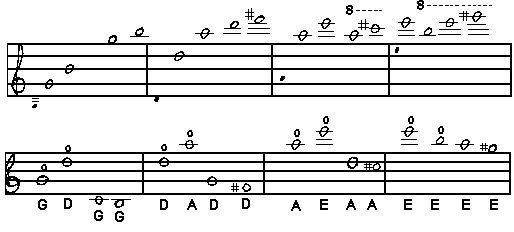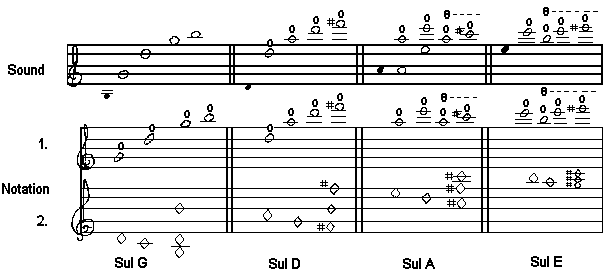Harmonics Conservatory of Music Columbus, Ohio Diagrams by Sheila  You can vibrate a string in 1/2 - 1/4 - 1/3 - 1/5. This corresponds to overtones which have frequencies of 2,3,4,5... times
the fundamental. For example, for an open A, these overtones would be 880Hz. Frequency means the number of vibration cycles per second. You can vibrate a string in 1/2 - 1/4 - 1/3 - 1/5. This corresponds to overtones which have frequencies of 2,3,4,5... times
the fundamental. For example, for an open A, these overtones would be 880Hz. Frequency means the number of vibration cycles per second.
A. If you place your finger in the middle of the string an octave above the pitch of the open string will result in a harmonic an octave higher than the pitch of the open string B. If you place your finger 1/3 of the string length from either end the result will be: 1. A perfect 5 above open pitch 2. At the point where the note would ordinarily be played. The result is a harmonic an octave and a fifth higher than the open pitch. C. If you place your finger 1/4 of the string length from either end a perfect 4th above open pitch or at the point where the note would ordinarily be played, the result is a harmonic 2 octaves higher than the open pitch. D. If you place your finger either a major 3rd above open string at the point where the note would ordinarily be played; two fifths of the string length from either end either a major 6th or a major 10th above open pitch and the result is a harmonic 2 octave and a major 3rd higher than the open pitch.

Artificial Harmonics


 Now give harmonics a try Now give harmonics a try
The first excerpt is from the Bela Bartok Rumanische Volkstanze the folling are from Introduction and Rondo Capriccioso by Camille Saint-SaŽns 

|


 Violin
Violin sheilascorner Home
sheilascorner Home Photography
Photography Websites
Websites